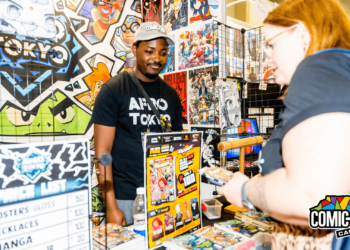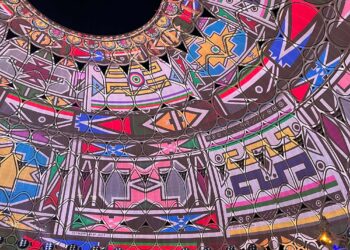Brighten your senses at the 6th iteration of the festival
A visit to Stellenbosch’s wine country is indeed a feast for the senses, but throwing a light art show into the mix becomes an unforgettable experience. Moreover, the university’s presence adds a dynamic element to the experience, fostering a space for intellectual exchange and dialogue. Visitors are treated to stunning visual displays and have the opportunity to engage in thought-provoking conversations about art, culture, and society.
This year’s Spier Light Art, curated by the esteemed Jat Pather and Vaughn Sadie, promises to be a highlight of the cultural calendar. Visitors meander through Spier Wine Farm’s enchanting vineyards and historic architecture and are immersed in sensory delights. The juxtaposition of the natural beauty of the Winelands with the innovative light installations creates a truly magical atmosphere.

Jenna Burchell, Songsmith (The Great Karoo). © Spier Light Art
Across the estate’s magnificent gardens are 15 captivating works by local and international artists. One piece by artist Hallie Haller accompanies her work with a thought-provoking message: “You are the first technology. A network of intention and hope that spills out into production and perception. You are the land maker. In the quick night, this is your chance to make it over. Take it somewhere good.” Haller’s words truly capture the essence of this year’s impressive Spier Light Art Exhibition.

Hallie Haller, Machine Swim. © Spier Light Art
Machine Swim challenges the idea that our interaction with machines always boosts productivity. It highlights adverse effects like retina damage and carpal tunnel syndrome, urging us to find a balance between technology and nature. It asks if we can use machines without losing our connection to the land, prompting reflection on our reliance on technology and the importance of harmonising with the natural world.
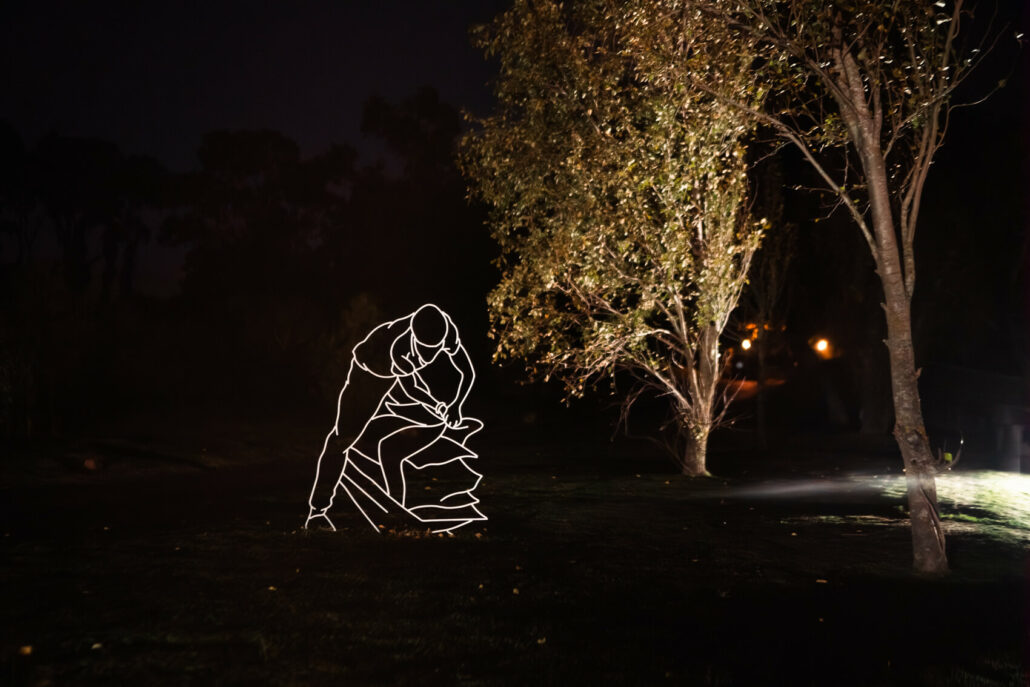
Kenneth Shandu, Invisible. © Spier Light Art
Invisible by Kenneth Shandu serves as a poignant visual narrative, delving deep into the everyday realities of economically marginalised individuals in post-Apartheid South Africa. At its core, ‘Invisible’ confronts the harsh reality that society is inherently stratified, with specific individuals enjoying privilege and access to resources while others are marginalised and disenfranchised. This systemic inequality perpetuates a cycle of disempowerment, particularly for those without a stable economic footing.
The artwork’s use of reflective wire figures is a masterful stroke, symbolising marginalised individuals’ invisibility in society. These figures, intricately crafted to capture the essence of everyday life, serve as a poignant reminder of the humanity that often goes unnoticed amidst the hustle and bustle of urban environments.
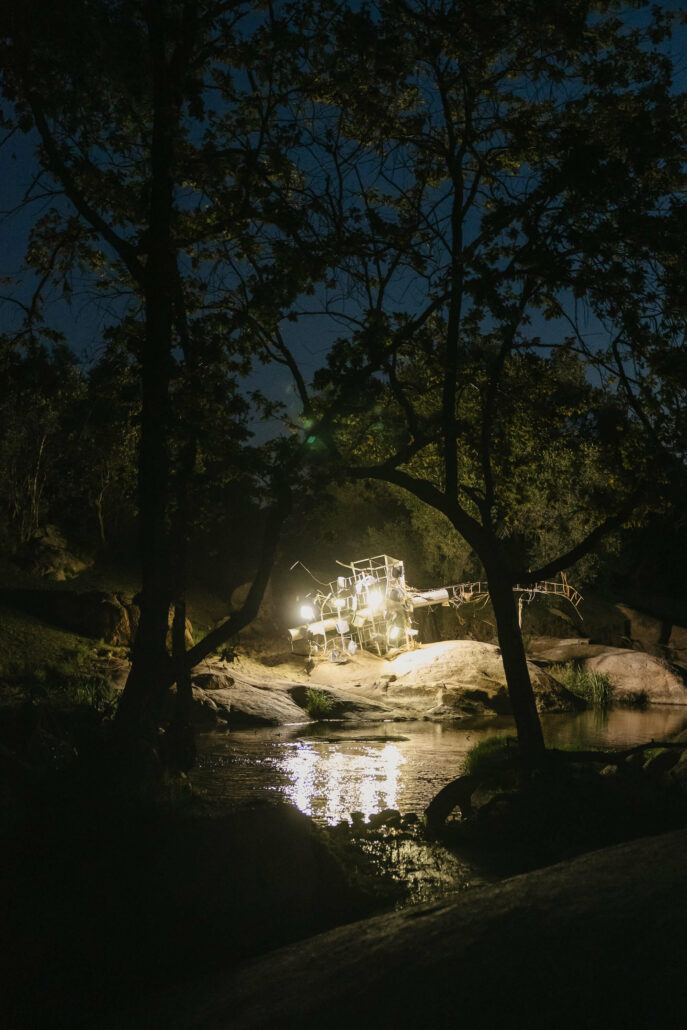
Abri de Swardt, Flood Light. © Spier Light Art
Flood Light by Abri de Swardt is a piece of art that recreates a floodlight commonly seen at the Danie Craven Rugby Fields, situated next to the river at Stellenbosch University’s Coetzenburg Sports Terrain. In a fictional scenario, the floodlight becomes disconnected from its mast and is swept away by severe flooding, eventually ending up at Spier.
In its new setting, Flood Light glitches and emits a distressed, mournful glow. Through its anxious and sorrowful appearance, the artwork highlights the ecological challenges of the current moment. Additionally, it symbolises our tendency to overlook or distract ourselves from these pressing environmental issues.
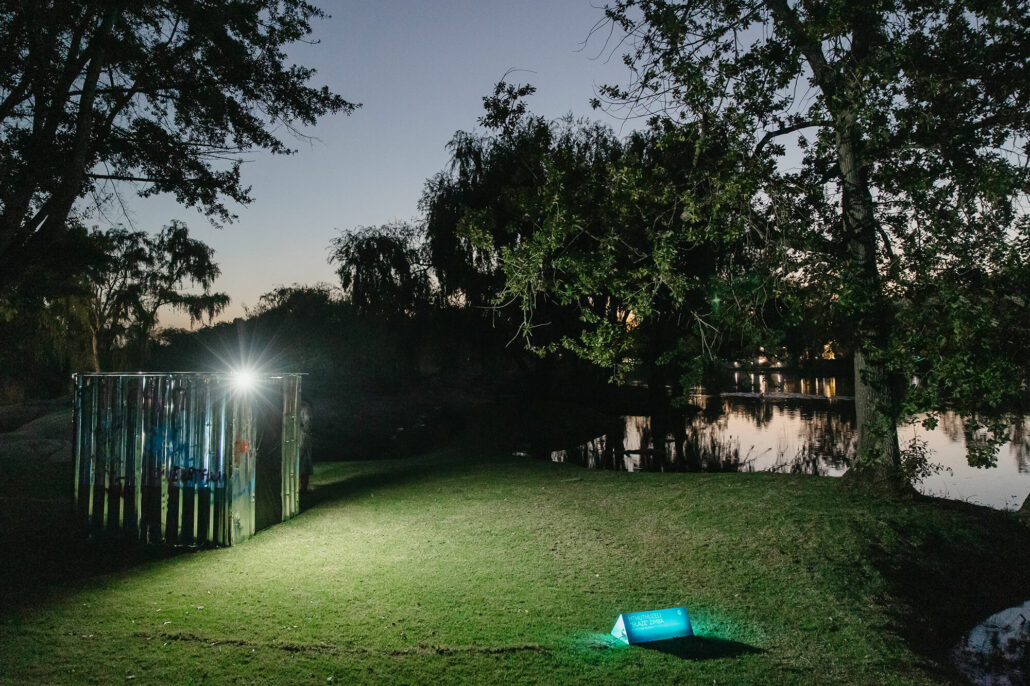
Mthuthuzeli “Blaze” Zimba, Moriti Wa Kganya. © Spier Light Art
In his piece, Moriti wa Kganya, Zimba takes a unique approach by dragging a shack on wheels from Khayelitsha to Cape Town’s CBD, capturing the journey on film and projecting it onto a shack installation. This artwork delves into the relationship between space, the human body, and light. By subverting and reimagining shack dwellings, Zimba challenges conventional perceptions. He incorporates sensors and modern Eurocentric lights to disrupt and politicise the experience of living in a shack.
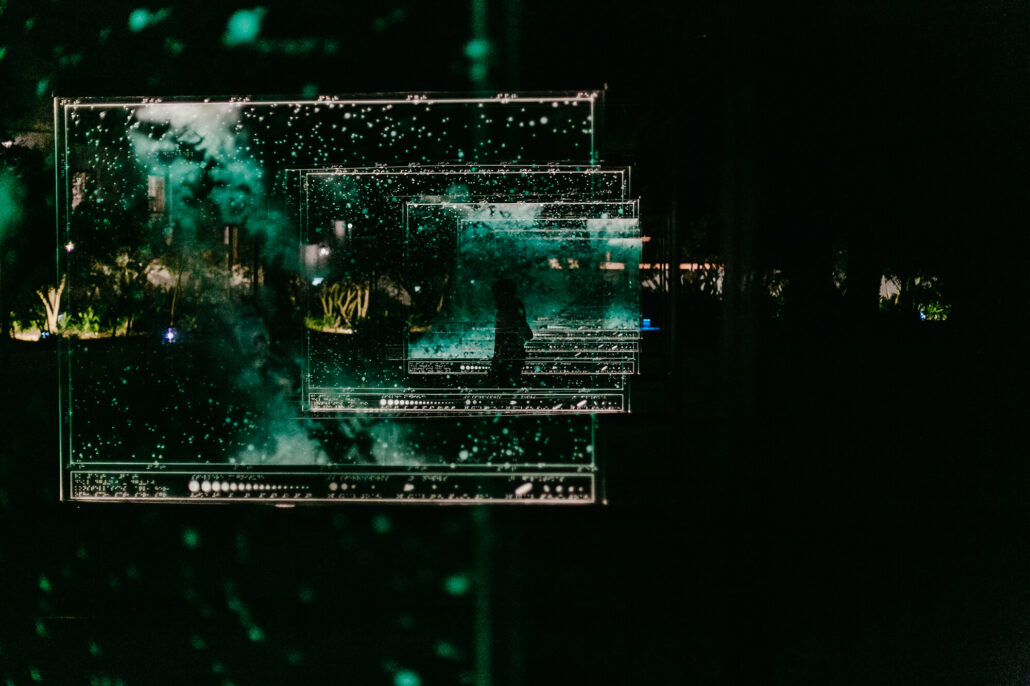
Berco Wilsenach, In Die Sterre Geskryf / Written In The Stars. © Spier Light Art
A key element in the presentation of Berco Wisenach’s In Die Sterre Geskryf / Written In The Stars is the use of successive glass panels. These panels are more than just physical barriers; they act as conduits for the viewer’s imagination, fostering a sense of depth and boundlessness. As viewers move through the installation, they are enveloped by the interplay of light and shadow, echoing the mysteries of the cosmos.
The artwork’s inclusion of Braille and star charts adds meaning and symbolism. It contemplates the interconnectedness of human experience, knowledge, and the cosmos. Through tactile engagement and visual exploration, viewers are invited to consider the vastness of the universe and their place within it.
This presentation serves as a loving tribute to Dick Enthoven, who commissioned the work in 2009. Enthoven’s memory is honoured by continuing his vision, allowing audiences to engage with the profound beauty and complexity of the universe in a meaningful and immersive way.

Kenneth Shandu, Invisible. © Spier Light Art
Set against the backdrop of Durban, a city teeming with life yet plagued by socio-economic disparities, ‘Invisible’ by Kenneth Shandu captures the mundane yet profound moments of those often invisible by societal norms. From moments of solitude to acts of resilience and survival, the artwork encapsulates the rich tapestry of experiences that define the lives of the economically marginalised.
Through ‘Invisible’, viewers are invited to confront their perceptions and biases, challenging them to see beyond the surface and recognise the humanity inherent in every individual. It is a powerful call to action, urging society to address the root causes of economic inequality and strive for a more inclusive and equitable future.
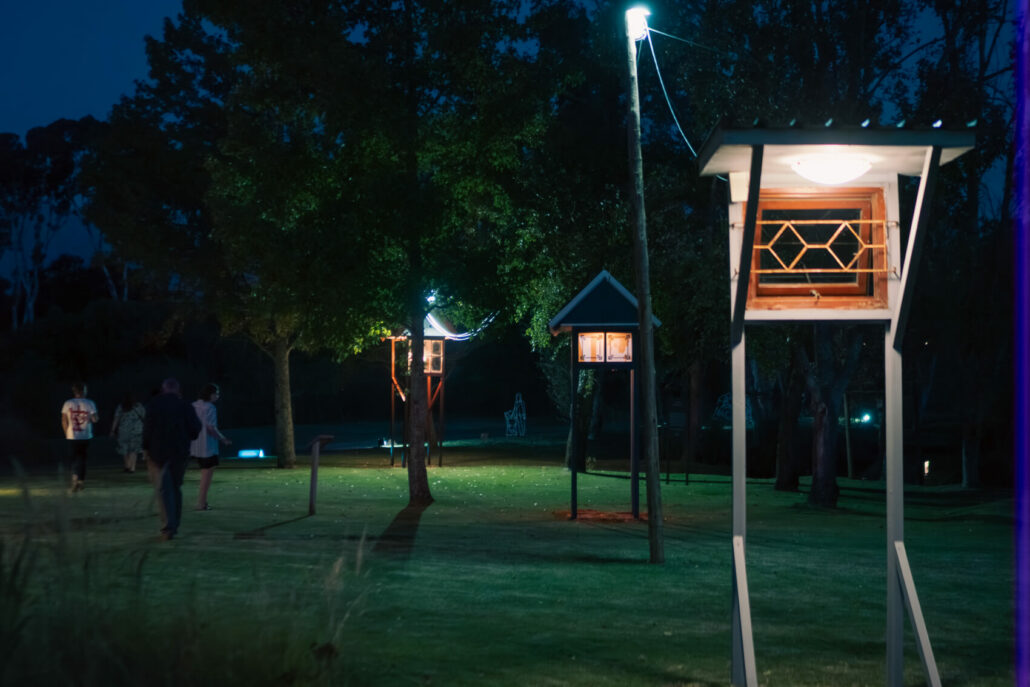
Qondiswa James and Themba Stewart, Keep The Lights On. © Spier Light Art
Keep The Lights On by Qondiswa James and Themba Stewart stands as a powerful testament to the socio-economic disparities that persist within the vibrant landscape of the City of Cape Town. At its heart, the artwork serves as a beacon of awareness, shedding light on the stark realities faced by residents of low – and low-to-medium – income communities who contend with inadequate public lighting, which puts them in dangerous situations after dark.
In these marginalised neighbourhoods, the absence or insufficiency of public lighting threatens personal safety and exacerbates the existing socio-economic inequalities. Already grappling with limited resources, residents find themselves further marginalised by the need for access to essential services.
Compounding this issue is the nation’s ongoing struggle with rolling blackouts, a symptom of more immense energy infrastructure challenges. While wealthier communities may have the means to invest in solar energy and backup batteries, many in poorer neighbourhoods are left without recourse, trapped in a cycle of energy insecurity.

Sophie Guyot, The Meaning Of Meaning. © Spier Light Art
Central to the artwork is the ingenious use of traffic lights as its primary material, transforming these mundane fixtures of urban life into potent symbols of universal communication. The artist crafts a visual language by manipulating simple luminous pictograms to bridge the vast expanse between humanity and hypothetical extraterrestrial intelligence.
In doing so, The Meaning of Meaning challenges conventional notions of communication, inviting viewers to question the inherent biases and limitations of our existing linguistic frameworks. The artwork encourages us to reconsider how we interpret and engage with the world around us by recontextualising familiar symbols within the context of cosmic inquiry.
Moreover, The Meaning of Meaning is a poignant meditation on our existence’s nature and place within the universe. As we contemplate the intricacies of interstellar communication, we are prompted to confront the fundamental questions of what it means to be human and to seek connection in a vast and unfathomable cosmos.
Through its thought-provoking imagery and profound thematic exploration, The Meaning of Meaning beckons us to embark on a journey of cosmic discovery, inviting us to ponder the mysteries of the universe and our place within it.
Other artists include Naadira Patel & Sarah De Villiers, Jenna Burchell, Mpho Jacobs, Stevie Thompson, Marco Chiandetti, Mhlonishwa Chiliza, Goldendean And Shruthi Nair, Alan Alborough, Charles Palm, Tiago Rodrigues, Kamil Adam Hassim and Rhoda Davids Abel. Informed by our history of struggle and slow progress, these artists continue to inspire and amaze us, reminding us that we have the power to shape a better future. So, as Haller encourages, let’s embrace our role as innovators and landmakers in the darkness, guiding our journey towards brighter days.
A trip to Spier wine estate during the light art exhibit is a journey of exploration and discovery, where the convergence of art, culture, and academia creates a truly unforgettable experience. Despite its imperfections, South Africa has intermittently provided hope and served as a model for human rights since the advent of democracy. Our artists boldly blend inspiration, innovation, and social consciousness, embodying our nation’s spirit of resilience and creativity. Artists employ hope and play uniquely and unmatched to navigate and address challenging subject matter.
For more information, please visit Spier Light Art.
Suzette Bell-Roberts is the Co-founder and Digital Editor of ART AFRICA magazine.
